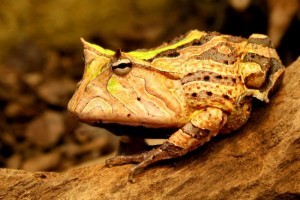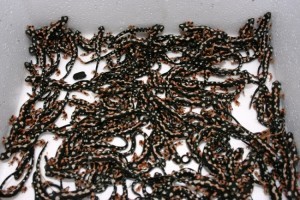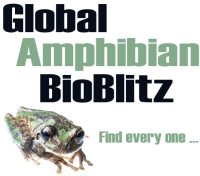Ex situ (captive) programs for amphibians can contribute to conservation in multiple ways. They can be the singular life-line keeping species from becoming extinct outright, like the Kihansi Spray Toad and 63 other species now classified by the IUCN as Extinct in the Wild (IUCN 2011). In addition, ex situ programs can contribute to the recovery of species that were or nearly were Extinct in the Wild, like the Wyoming Toad, Puerto Rican Crested Toad, and Mallorcan Midwife Toad. Ex situ programs can also contribute to conservation via conservation education, advocacy, fundraising, and research.
 It is also possible that ex situ programs can contribute to conservation by producing surplus captive-bred animals for sale, which can create conservation funding and undermine trade in wild animals. This is, however, a contentious issue within the ex situ community, not something that Amphibian Ark necessarily endorses, but also not something that we necessarily disapprove of.
It is also possible that ex situ programs can contribute to conservation by producing surplus captive-bred animals for sale, which can create conservation funding and undermine trade in wild animals. This is, however, a contentious issue within the ex situ community, not something that Amphibian Ark necessarily endorses, but also not something that we necessarily disapprove of.
Sometimes sales are driven purely by profit and might benefit the species only incidentally through associated relief of in situ collection pressure, or driven in some part by conservation motive and (perhaps in addition to alleviating collection pressure) producing funds that are invested in protecting that (or other) species in the wild.
Examples of purely commercial endeavors that potentially relieve collection pressures include the production of threatened species for research, food (e.g., giant salamanders), and pets (e.g., dendrobatids www.saurian.net).
Other programs are more conservation motivated and use some proceeds from sales to fund conservation.
 This is an area almost all association-accredited zoos avoid, although most do work collaboratively to trade surplus captive-bred animals among themselves for conservation education and in that way reduce their own collection pressures. For example, captive production of dendrobatid poison frogs, which are very popular exhibit animals, has become nearly self-sufficient with 92% of animals for which origins are reported listed by Species360 as captive-bred. We know of two examples of accredited zoos involved with the sale of surplus captive-bred amphibians outside the zoo community to fund conservation work. Sedgwick County Zoo is producing surplus Neurergus salamanders and selling them into the pet trade through Sandfire Dragon Ranch to fund range-country work. Similarly the Cologne Zoo’s partner program in Vietnam is selling surplus amphibians into the trade to fund the facility’s work.
This is an area almost all association-accredited zoos avoid, although most do work collaboratively to trade surplus captive-bred animals among themselves for conservation education and in that way reduce their own collection pressures. For example, captive production of dendrobatid poison frogs, which are very popular exhibit animals, has become nearly self-sufficient with 92% of animals for which origins are reported listed by Species360 as captive-bred. We know of two examples of accredited zoos involved with the sale of surplus captive-bred amphibians outside the zoo community to fund conservation work. Sedgwick County Zoo is producing surplus Neurergus salamanders and selling them into the pet trade through Sandfire Dragon Ranch to fund range-country work. Similarly the Cologne Zoo’s partner program in Vietnam is selling surplus amphibians into the trade to fund the facility’s work.
On the other hand, this is an area where the private sector is not so restricted. Two frog-ranching projects in Peru potentially reduce the demand for wild-caught frogs while simultaneously re-investing money into habitat protection and local communities (www.inibico.org and www.understoryenterprises.com). An Ecuadorian NGO uses the sale of third-generation captive-bred frogs to fund conservation research, education, and habitat restoration (www.wikiri.com.ec). A private frog conservationist in Australia uses the sale of captive-bred non-threatened frogs to fund in part his work with Critically Endangered frog species (www.frogs.org.au/arc/frogs.html). Two hobbyist organizations have raised money through the sale of captive-bred amphibians to buy key habitat areas in Latin America: the Mid-Atlantic Reptile Show (MARS) has purchased and protects almost 3,000 acres of rainforest in Costa Rica, while Dendrobatidae Nederland (DN) was one of several partners forming the ProAves Ranita Dorada Amphibian Nature Reserve in Colombia.
The ethics of conservationists selling animals aside, these contributions can be significant. One could argue that the need for wholesale captive-breeding operations to reduce over-harvesting is global and profound (Carpenter et al. 2007) and that this is an area where AArk partners, particularly those in the private sector, are uniquely positioned to make a considerable contribution.
Carpenter, A.I., H. Dublin, M. Lau, G. Syed, J.E. McKay, and R.D. Moore. 2007. Chapter 5: Over-harvesting. Pp. 26-31 In Amphibian Conservation Action Plan. Gascon, C., J.P. Collins, R.D. Moore, D.R. Church, J.E. McKay, and J.R. Mendelson III (Eds.). IUCN/SSC Amphibian Specialist Group, Gland, Switzerland.













